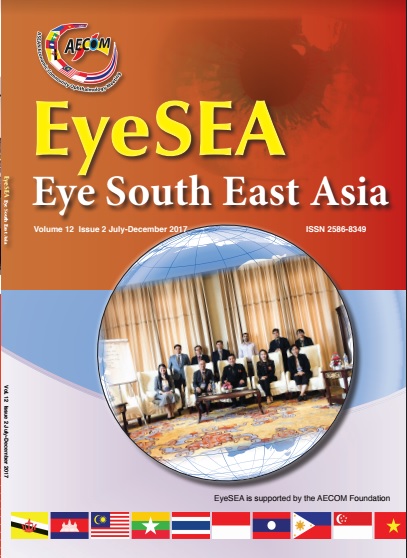THE CHANGE OF CORNEAL CURVATURES AFTER MICRO-TRABECULECTOMY SURGERY AMONG VIETNAMESE GLAUCOMA PATIENTS
Main Article Content
Abstract
ABSTRACT
Title: The change of corneal curvatures after micro-trabeculectomy surgery among Vietnamese glaucoma patients.
Background: There has been few reports on analysing astigmatism after standard trabeculectomy and only one study about micro trabeculectomy by Vernon in 1991; there were none which compared 2 groups in one individual study.
Purposes: To compare the postoperative changes of corneal curvature (surgical induce astigmatism–SIA) between two different glaucoma surgery techniques: microtrabeculectomy and standard trabeculectomy.
Methods: A randomized clinical study was done including 81 eyes (81 patients) who were randomized selected to perform either standard trabeculectomy (3x4 mm scleral flap) or micro-trabeculectomy (2x2 mm scleral flap), both with antifibrotic 5- Fluorouracil. Patients’ pre- and postoperative detailed ophthalmologic examinations were documented and topographic keratometric values (flattest K, steepest K) were noted. Vector analysis was performed on the data using a computerized method to calculate the SIA for each eye at 1st day, 4th , 12th, 24th week follow-up postoperatively.
Results: The median SIA power reduced gradually from 1.89 Diopter to 1.30, 0.95, 0.73, 0.60 Diopter in the standard group and from 1.03 Diopter to 0.92, 0.83, 0.74, 0.73 Diopter in the micro group at 1 day, 1st week, 4th week, 12th week and 24th week follow-up respectively. The SIA power values in standard group was significantly higher than the values in micro group at 1st day and 1st week postoperatively. There was no correlation between SIA and IOP in standard and micro-trabeculectomy group.
Conclusion: Micro-trabeculectomy is an invasive filtration procedure which caused minimally statistically significant induced astigmatism.
Conflicts of Interest: No
Key words: micro-trabeculectomy, surgically induced astigmatism, keratometer.
Article Details
References
Adio A, Aruotu N. Induced astigmatism after cataract surgery - a retrospective analysis of cases from the University of Port Harcourt Teaching Hospital. 2011; 2(70):75-80.
Ashai M, Ahmed A, Ahsan M, Imtiaz A. The effect of trabeculectomy on corneal astigmatism. Jammu and Kashmir Practitioner. 2006; 1(13):27-9.
Cairns J. Trabeculectomy: Preliminary report of a new medthod. Am J Ophthalmol. 1968;(66):673-679.
Claridge K, Galbraith J, Bates A. The effect of trabeculectomy on refraction, keratometry and corneal topography. Eye. 1995;(9):292-298.
Cunliffe I, Dapling R, West J, Longstaff S. A prospective study examining the changes in factors that affect visual acuity following trabeculectomy. Eye. 1992; 6(6):618-622.
Dalton M. Eyeworld.org. [Online].; 2012. Available from: http://www.eyeworld.org/article-determining-your-surgically-induced-astigmatism .
Kumari R, Saha B, Puri L. Keratometric astigmatism evaluation after trabeculectomy. Nepal J Ophthalmol. 2013; 5(10):215-219.
Marwat S, Nnazullah , Rasul J. Frequency of corneal astigmatism after primary trabeculectomy. KJMS. 2013; 6(1):121-125.
Naeser K. Assessment and statistics of surgically induced astigmatism. Acta Ophthalmol. 2008; 86:5-28.
Rosen W, Mannis M, Brandt J. The effect of trabeculectomy on corneal topography. 1992; 23(6):395-398.
Sawhney S, Aggarwal A. SIA Analysis: A step by step approach. Technical Ophthalmology. 2015; 1.
Vernon S, Gorman C, Zambarakji H. Medium to longterm intraocular pressure control following small flap trabeculectomy (microtrabeculectomy) in relatively low risk eyes. Br J Ophthalmol. 1998;(82): 1383-1386.
Vernon S, Spencer A. Intraocular pressure control following microtrabeculectomy. Eye. 1995; 9: 299-303.
Vernon S, Zambarakji H, Potgieter F. Topographic and keratometric astigmatism up to 1 year following small flap trabeculectomy(microtrabeculectomy). Br J Ophthalmol. 1999; 83: 779-782.
Wells T. State of the art techniques in glaucoma surgery. Glaucoma Now. 2011; 2:2-5.


